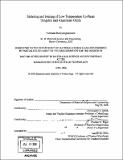| dc.contributor.advisor | Christopher A. Schuh and Thomas W. Eagar. | en_US |
| dc.contributor.author | Boonyongmaneerat, Yuttanant | en_US |
| dc.contributor.other | Massachusetts Institute of Technology. Dept. of Materials Science and Engineering. | en_US |
| dc.date.accessioned | 2007-09-27T20:16:39Z | |
| dc.date.available | 2007-09-27T20:16:39Z | |
| dc.date.copyright | 2006 | en_US |
| dc.date.issued | 2006 | en_US |
| dc.identifier.uri | http://dspace.mit.edu/handle/1721.1/36204 | en_US |
| dc.identifier.uri | http://hdl.handle.net/1721.1/36204 | |
| dc.description | Thesis (Ph. D.)--Massachusetts Institute of Technology, Dept. of Materials Science and Engineering, 2006. | en_US |
| dc.description | Includes bibliographical references (p. 181-189). | en_US |
| dc.description.abstract | Conventional methods used to fabricate co-fired tungsten/alumina composites usually rely on high temperature processing (>1500C). As it would be beneficial or even necessary for some applications to produce such composites at relatively low firing temperatures, low-temperature processing techniques and the attendant knowledge of processing-property relationships need to be developed. In this thesis, a set of experiments and simulations are performed to obtain a better understanding of sintering and joining of the tungsten/alumina system processed at temperatures near or below 12000C. The technique of activated sintering for tungsten is investigated, whereby a minimal content of additives enables low firing temperatures through a change in the sintering mechanism for tungsten. Tungsten compacts produced by this method are found to sinter only to the "initial stage" and are characterized by high residual porosity level. Hardness and fracture toughness of such partially-sintered materials are examined experimentally and analytically, and dependence of mechanical properties on the relative particle neck size is observed. Various studies are carried out to examine both fundamental and practical aspects of joining co-fired tungsten/alumina. | en_US |
| dc.description.abstract | (cont.) First, contributions to adhesion of co-sintered bilayers are studied where the properties of the tungsten layer are controlled using the process of activated sintering. Using a bending delamination test, improvements in sintered density of tungsten are found to increase the adhesive strength of the system only up to a point, beyond which shrinkage mismatch compromises the intrinsic toughness of the interface. A study of low-temperature co-fired tungsten/alumina is then focused on composite shells for an investment casting application. The influences of various processing parameters in a slurry-based route on the sintering and adhesion properties of tungsten/alumina are investigated. Binder content, stucco sand application, and powder characteristics are among the parameters found to critically control the quality of tungsten/alumina shells produced. Finally, the feasibility of several joining strategies, which involve the use of chemical additives, is examined on co-fired tungsten/alumina compacts processed at low temperatures. Some bonding techniques are verified to help improve the bonding of the co-sintered composites. | en_US |
| dc.description.statementofresponsibility | by Yuttanant Boonyongmaneerat. | en_US |
| dc.format.extent | 189 p. | en_US |
| dc.language.iso | eng | en_US |
| dc.publisher | Massachusetts Institute of Technology | en_US |
| dc.rights | M.I.T. theses are protected by copyright. They may be viewed from this source for any purpose, but reproduction or distribution in any format is prohibited without written permission. See provided URL for inquiries about permission. | en_US |
| dc.rights.uri | http://dspace.mit.edu/handle/1721.1/36204 | en_US |
| dc.rights.uri | http://dspace.mit.edu/handle/1721.1/7582 | |
| dc.subject | Materials Science and Engineering. | en_US |
| dc.title | Sintering and joining of low temperature co-fired tungsten and aluminum oxide | en_US |
| dc.type | Thesis | en_US |
| dc.description.degree | Ph.D. | en_US |
| dc.contributor.department | Massachusetts Institute of Technology. Department of Materials Science and Engineering | |
| dc.identifier.oclc | 76894245 | en_US |
